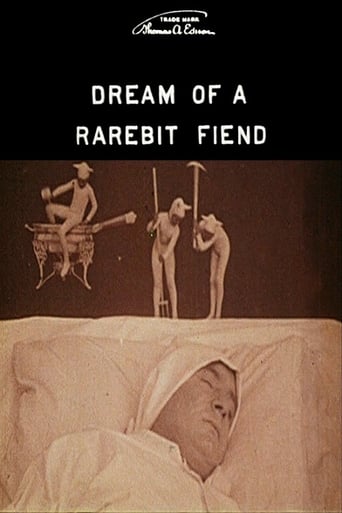cricket crockett
. . . perhaps is the best way to describe Edwin S. Porter, the director of the Edison Manufacturing Company 6 minute, 27-second-long 1906 short DREAM OF A RAREBIT FIEND and Winsor McCay, the newspaper comic script cartoonist upon whose Jan. 28, 1905 strip for the New York EVENING TELEGRAM this film is based. At a time when Edison's competitors were churning out three flicks daily (not unlike Valley porn creators of the late 1900s) to meet a supply shortage ( = making more money), Porter dilly-dallied with this comparatively short piece for EIGHT WEEKS, as if he were fine-tuning the Mona Lisa's smile. The most original things the normally glib liars who typed out the Edison Film Catalogs could come up with in regard to their RAREBIT FIEND product--pegged at $70.50, pricey for its day--was calling Porter's film strip "humorously humorous and mysteriously mysterious" (how long would a character last on AMC's show MADMEN with such paucity of verbal gifting?). Similarly, McCay's original scripts featured scribbled dialog balloons, which were illegible when reproduced in the newspaper. The phrase which best sums up McCay and Porter's approach to mass entertainment: "I'm just gonna do what I want to do, hang the public!"
tavm
I saw two versions of this live-action version of Winsor McCay's comic strip Dreams of a Rarebit Fiend. The Google Video version had music suitable for the era and film. The YouTube version (which Google now links to as well) used Carl Stalling's music for Warner Bros. cartoon shorts along with Treg Brown's sound effects that seemed WAY unsuitable. Director Edwin S. Porter gives wonderful visual touches throughout from the whirling lamppost sequence to depict drunkenness to the bed jumping up and down while the drunk tries to sleep to his dreams of three devils picking at his head to him hanging on a swinging weather vane. Two bad the print of both versions were downright poor with washed out frames nearly constantly. Recommended mainly for film enthusiasts.
Polaris_DiB
Placed under the "American Surrealism" genre, apparently, this film is still a fun and very quirky look into the effects of binge drinking.It's rather absurd and silly by today's standards but the silliness lends itself to a sort of contemporary audacity not really seen in very much cinema anymore. Multiple exposures are the special effects trick of this film as the fiend goes through many harrowing experiences, my favorites including his flying over the city and the little demons pounding on his head.It never ceases to amaze me how fast cinema developed from boring and cumbersome shots of factories and people moving to narratives and special effects. Whether this film is any "good" by the standards of then or now doesn't interest me anymore. It's fun and has an air of historicalness to it that makes it worth the time.--PolarisDiB
Snow Leopard
With a slight but bizarre story, and all kinds of special visual effects, this is one of the weirder but more interesting features of its era. It's not really a great film, since some parts of it don't quite work as well, but it's very interesting, and it would still be interesting even if it had been made some years later.The story comes from some of Winsor McCay's comic strips about the "Rarebit Fiend", and the offbeat material indeed seems ready-made for cinema. There is just enough to the scenario to allow for a wide range of camera effects. Several sequences effectively and creatively combine panning shots and stationary views superimposed on each other to create an effect. The "whirling" effect, towards the beginning of the movie, might be the best one.There are a number of other features from the first decade of the 1900s that might be even better in terms of the visuals, and/or that are more enjoyable as narratives, but this is still one of the movies that those who enjoy watching these very old films should make a point of seeing. It's unusual, experimental, and interesting.

